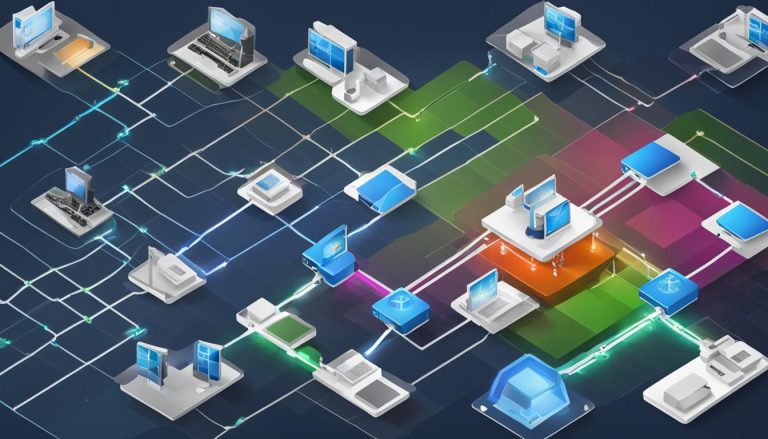Have you ever wondered how devices on a network are assigned IP addresses? That’s where DHCP, or Dynamic Host Configuration Protocol, comes in. In this article, I will explain what DHCP is, how it works, its components, uses, and its pros and cons.
Key Takeaways
- DHCP is a network management protocol that automates the assignment of IP addresses to devices on a network.
- It eliminates the need for manual configuration and ensures efficient IP address distribution.
- DHCP uses a client-server model and works by dynamically assigning IP addresses to DHCP clients.
- It provides additional configuration information such as subnet mask, default gateway IP address, and DNS addresses.
- DHCP can be used with both IPv4 and IPv6 protocols.
How Does DHCP Work
DHCP (Dynamic Host Configuration Protocol) operates using a client-server model, facilitating the automatic assignment of IP addresses to devices on a network. When a DHCP-enabled device connects to the network, it sends a broadcast request to discover a DHCP server. The server, in turn, responds with an offer that includes an available IP address and related configuration information.
Following this, the client sends a request to the server, formally requesting the use of the offered IP address. The server acknowledges the request and marks the IP address as leased in its database. The client then receives the IP address and configuration settings from the server, utilizing them to communicate on the network.
It is essential to note that the lease duration determines how long the client can utilize the assigned IP address before needing to request a renewal. DHCP servers manage a record of all allocated IP addresses and prevent duplicates by using the client’s MAC address for identification. Additionally, DHCP is versatile and can be configured to provide addressing to multiple subnets through the use of DHCP relay services.
Understanding the inner workings of DHCP is crucial for network administrators in efficiently managing IP address configurations and optimizing network connectivity.
The DHCP Workflow in Summary:
- The client sends broadcast request to discover a DHCP server.
- The server responds with an offer including an available IP address and related configuration information.
- The client sends a request to the server, formally requesting the use of the offered IP address.
- The server acknowledges the request, marks the IP address as leased, and updates its database.
- The client receives the IP address and configuration settings from the server.
- The lease duration determines how long the client can use the assigned IP address before requesting renewal.
Components of DHCP
DHCP consists of several key components that work together to automate the assignment of IP addresses and configuration settings on a network. These components include:
- DHCP Server: The DHCP server is responsible for running the DHCP service and managing a pool of available IP addresses and configuration information. It receives requests from DHCP clients and provides them with the necessary network settings.
- DHCP Client: The DHCP client is a device that connects to the network and requests an IP address configuration from the DHCP server. It sends a broadcast request to discover a DHCP server and receives the assigned IP address and configuration settings.
- DHCP Relay: The DHCP relay is used in large or complex networks to help manage requests between DHCP clients and servers. It forwards DHCP messages between clients and servers located on different subnets.
- IP Address Pool: The IP address pool is a range of available IP addresses that the DHCP server can assign to clients. It ensures that each client receives a unique IP address when connecting to the network.
- Subnet: A subnet represents a division of the network and helps organize devices into smaller logical networks. DHCP can be configured to provide addressing to multiple subnets using DHCP relay services.
- Lease: The lease specifies the duration of the IP address allocation to a client. Once the lease expires, the client must request a renewal from the DHCP server to continue using the assigned IP address.
- DHCP Communications Protocol: The DHCP communications protocol defines the format and rules for communication between DHCP clients and servers. It ensures standardized and reliable exchanges of information during the IP address assignment process.
Table: Summary of DHCP Components
| Component | Description |
|---|---|
| DHCP Server | Runs the DHCP service and manages IP address pool and configuration information. |
| DHCP Client | Connects to the network and requests IP address configuration from the DHCP server. |
| DHCP Relay | Forwards DHCP messages between clients and servers located on different subnets. |
| IP Address Pool | A range of available IP addresses for DHCP server to assign to clients. |
| Subnet | A division of the network, helps organize devices into smaller logical networks. |
| Lease | Specifies the duration of the IP address allocation to a client. |
| DHCP Communications Protocol | Defines the format and rules for communication between clients and servers. |
These components work together to facilitate the automatic configuration of IP addresses and relevant network settings, making DHCP a crucial protocol for efficient network management.
DHCP Uses and Functions
DHCP (Dynamic Host Configuration Protocol) serves several important uses in network management. It simplifies the process of IP address distribution and configuration settings on client devices, eliminating the need for manual configuration and reducing the risk of errors. DHCP provides centralized and automated TCP/IP configuration, making it easier to define and assign additional configuration values such as subnet masks, default gateways, and DNS server addresses.
One of the main functions of DHCP is to distribute IP addresses within a network. It automates the process of assigning unique addresses to devices, ensuring efficient utilization of available addresses and preventing conflicts. With DHCP, network administrators can easily manage the allocation and reallocation of IP addresses, especially in networks with a large number of devices or frequent device movement.
The configuration of subnet masks, default gateways, and DNS server addresses is another significant function of DHCP. Subnet masks define the range of IP addresses available in a network, default gateways provide a path for devices to access external networks, and DNS server addresses enable devices to translate domain names into IP addresses for internet communication. DHCP simplifies the configuration of these settings by providing them automatically to client devices, reducing the administrative efforts and ensuring consistent network connectivity.
“DHCP automates the process of IP address distribution and configuration, simplifying network management and reducing errors.”
| Function | Description |
|---|---|
| IP address distribution | Automatically assigns unique IP addresses to devices on a network, ensuring efficient utilization and preventing conflicts. |
| Subnet mask configuration | Provides subnet mask information to client devices, defining the range of IP addresses available in a network. |
| Default gateway configuration | Automatically assigns default gateway IP addresses to client devices, enabling access to external networks. |
| DNS server configuration | Provides DNS server addresses to client devices, enabling domain name resolution for internet communication. |
Pros and Cons of DHCP
When it comes to network management, DHCP offers several advantages that make it a popular choice. One of the main benefits of DHCP is its ability to simplify the process of adding or moving devices within a network. Instead of manually configuring IP addresses, DHCP automates the assignment process, saving time and reducing the risk of configuration errors. This is especially valuable in large networks where managing IP addresses manually can be a cumbersome task.
Additionally, DHCP centralizes the management of TCP/IP configurations. By using DHCP, network administrators can define and assign additional configuration values such as subnet masks, default gateways, and DNS server addresses from a central location. This not only streamlines the configuration process but also ensures consistency and accuracy across the network.
However, it’s important to note that DHCP is not without its disadvantages. One of the main concerns is security. DHCP lacks built-in mechanisms for client-server authentication, making it vulnerable to deception and attacks. Malicious actors can compromise a DHCP server and cause disruptions to the network. To mitigate this risk, it’s crucial to implement security measures such as regularly updating DHCP server software, ensuring proper access controls, and monitoring for any suspicious activities.
While DHCP offers numerous benefits in terms of IP address management and configuration, it’s essential to address security concerns and implement best practices to minimize risks.
Table: Pros and Cons of DHCP
| Pros | Cons |
|---|---|
| Simplifies the process of adding or moving devices | Potential security vulnerabilities |
| Reduces configuration errors | Lacks built-in client-server authentication |
| Centralizes the management of TCP/IP configurations | Possible disruptions if DHCP server is compromised |
Overall, DHCP is a valuable network management protocol that offers automation and efficiency in IP address assignment and configuration. By leveraging its benefits and implementing proper security measures, organizations can optimize their network connectivity and enhance overall network management.
Conclusion
In conclusion, DHCP (Dynamic Host Configuration Protocol) is a crucial network management protocol that automates the assignment of IP addresses and configuration settings. It simplifies the process of network administration and ensures efficient IP address distribution, eliminating manual configuration and reducing the risk of errors. DHCP works through a client-server model, with the server offering available IP addresses and the client requesting to use them.
The components of DHCP include the DHCP server, DHCP client, DHCP relay, IP address pool, subnet, lease, and DHCP communications protocol. The server holds a pool of available IP addresses and configuration information, while the client requests an IP address configuration. The relay helps manage requests between clients and servers, and the various components work together to facilitate smooth communication.
While DHCP offers numerous benefits, such as centralized management and automated configuration, it is crucial to address security concerns. DHCP is not inherently secure, and precautions must be taken to prevent unauthorized access or attacks. Implementing best practices and ensuring server availability through backup servers are essential steps to mitigate risks and maintain a secure network environment.
FAQ
What is DHCP?
DHCP stands for Dynamic Host Configuration Protocol. It is a network management protocol that automates the process of assigning IP addresses to devices on a network.
How does DHCP work?
DHCP works through a client-server model. When a DHCP-enabled device connects to a network, it sends a broadcast request to discover a DHCP server. The server responds with an offer that includes an available IP address and related configuration information. The client then sends a request to the server, requesting to use the offered IP address. The server acknowledges the request and marks the IP address as leased in its database. The client receives the IP address and configuration settings from the server and uses them to communicate on the network.
What are the components of DHCP?
The key components of DHCP include the DHCP server, which holds a pool of available IP addresses and configuration information, the DHCP client, which requests an IP address configuration from the server, and the DHCP relay, which helps manage requests between clients and servers. Other components include the IP address pool, the subnet, the lease, and the DHCP communications protocol.
What are the uses and functions of DHCP?
DHCP is primarily used to distribute IP addresses within a network and configure relevant network settings on client devices. It automates the process of IP address distribution, eliminates the need for manual configuration, and reduces the risk of errors. DHCP also provides centralized and automated TCP/IP configuration, making it easier to define and assign additional configuration values such as subnet masks, default gateways, and DNS server addresses.
What are the pros and cons of DHCP?
The advantages of DHCP include simplifying the process of adding or moving devices within a network, reducing configuration errors, centralizing the management of TCP/IP configurations, and efficiently handling IP address changes. However, DHCP is not inherently secure and can be vulnerable to attacks. It is important to address DHCP security vulnerabilities and implement best practices to minimize risks.
Hi, I’m Mark, the author of Clever IT Solutions: Mastering Technology for Success. I am passionate about empowering individuals to navigate the ever-changing world of information technology. With years of experience in the industry, I have honed my skills and knowledge to share with you. At Clever IT Solutions, we are dedicated to teaching you how to tackle any IT challenge, helping you stay ahead in today’s digital world. From troubleshooting common issues to mastering complex technologies, I am here to guide you every step of the way. Join me on this journey as we unlock the secrets to IT success.


